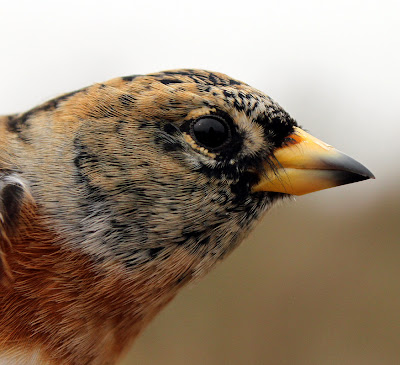Morning rain put paid to any huge ambition today, so when the rain cleared about midday leaving little wind but with a grey sky I decided to head to Rawcliffe where I could check the feeding station.
There seemed to be a decent number of Chaffinch and Brambling about again, all scattering from the seed drop zone as I approached, so I put up a couple of nets before leaving a couple of litres of seed.
I caught just three Bramblings, 2 new and a recapture from recent days before the wind sprung up unannounced causing me to take the nets down again. It was very annoying again after a similar episode last week, but the few Bramblings pushed my total here to 51 new ones during the full winter period.
When I looked at the data on IPMR these birds split as 42 juvenile/second calendar year and 9 adults roughly 50/50 each sex.
Brambling - second calendar year male
Brambling - second calendar year male
It stayed dry but very overcast so a little birding was in order. Finches around the feeding area totalled 10 Brambling, 10 Chaffinch, 14 Goldfinch and 4 Reed Bunting, a reduction in recent numbers. I note that after the recent dry spell many fields which remained as stubble throughout the winter have now been ploughed, thus leaving less fields for finches and others to feed in. If only we could have such stubble fields every winter, as we used to do before farmers took to winter crops.
Buzzards are a permanent fixture here on the moss with the 4 individuals I saw today in the overcast skies representing 4 breeding sites I know of, with many more not too far away. Other raptors pm were a Sparrowhawk molesting one of the above Buzzards and a Peregrine which came from the direction of Pilling and scattered roughly 90 Woodpigeons from the tree tops of the nearby conifer plantation.
Over towards Lancaster Lane the Lapwings and Starlings indulged in periodic panic with many hundreds in the air together at times giving rough counts of 280 and 600 respectively. A couple of Lapwings have now taken up residence on the farm in the same areas used in previous years.
Other sightings: 60+ Curlew heading north, 2 Yellowhammer, 18 Corn Bunting, 40+ Tree Sparrow, 4 Song Thrush (2 pairs) and 9 Roe Deer.
The nine deer were in separate groups of 4 and 5 animals. As an aside, and from the national newspapers today - “There are currently around 1.5million deer in the UK, and experts say that unless numbers are managed, the deer population will escalate out of control and they will soon be considered vermin”. I wouldn’t say deer are a major problem around but I know they break through electric fences causing valuable livestock to wander and to occasionally get lost.
Roe Deer
Back to the birds. The Corn Bunting picture was taken on a sunnier day than today but it’s the tree the buntings always fly to when they have been disturbed from their favoured feeding spot.
Corn Bunting
A bit of a short day and a rather undersized post but please tune in to Another Bird Blog soon for the better birding experience.

















.jpg)













5 comments:
The wind is an annoyance around here lately, too. So aggravating, although my aggravation lies in trying to photograph a bird as the wind whips the branches around. Not fun! Enjoyed your shots and learning about the different species and numbers in your area.
With migration beginning, it has been hard to stay home and not go out to find all the birds! There are so many! The worst days are the windiest but each day brings us something new....and that is exciting! Happy birding!
Superb close-up of the Brambling, Phil. You must have used a dedicated macro lens. I'm surprised and happy to hear the deer are doing so well and I hope the buzzards can stay around. We only get them in Japan for winter but I'd be happy to see them more often.
I had no idea deer were so common these days.................
Birding and the wind just do not go together. Is it an old wives tale about March winds? The Lapwing sighting would be one of my favorites. And your Brambling closeup is awesome. Happy Birding and have a great weekend, Phil!
Post a Comment